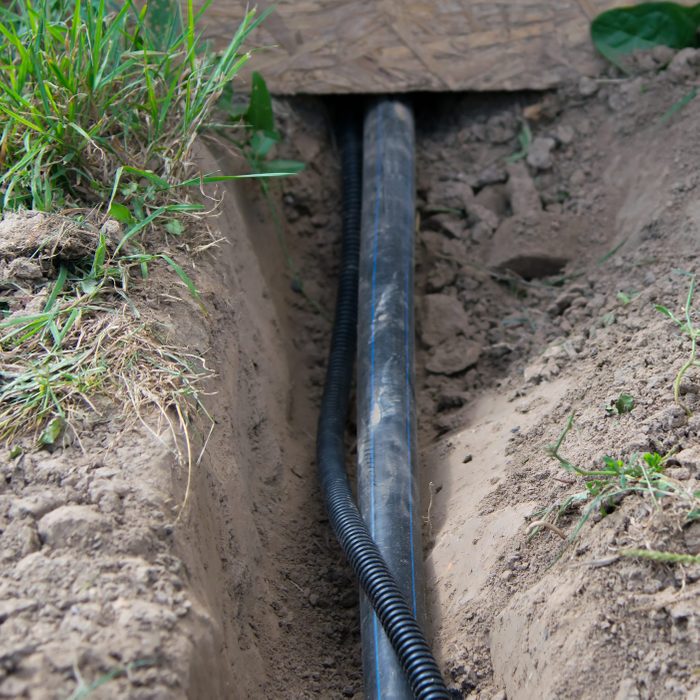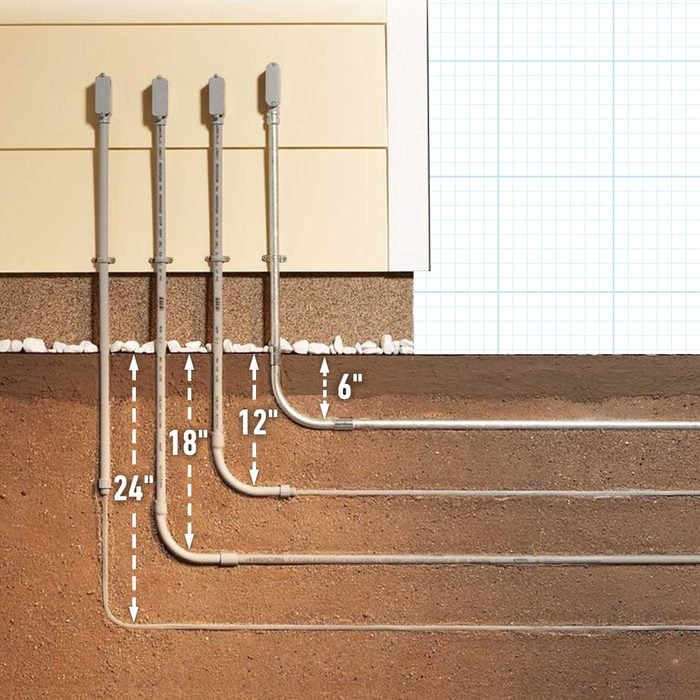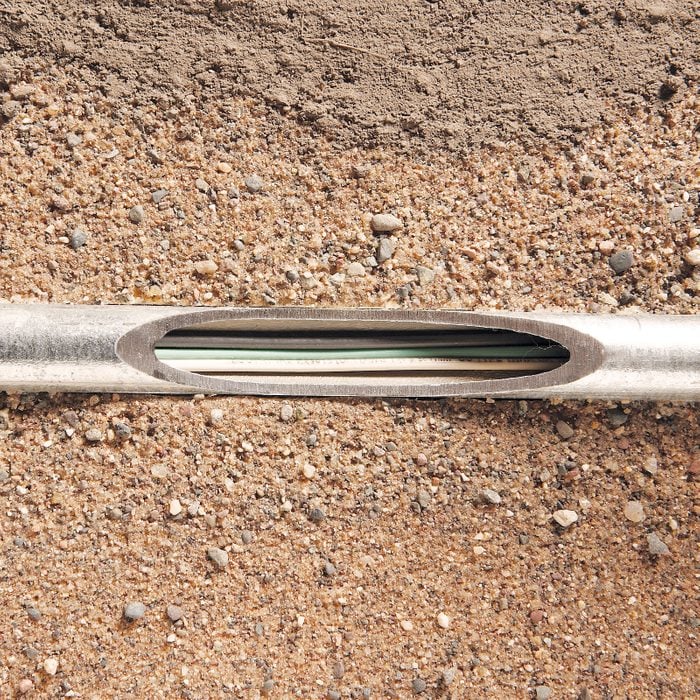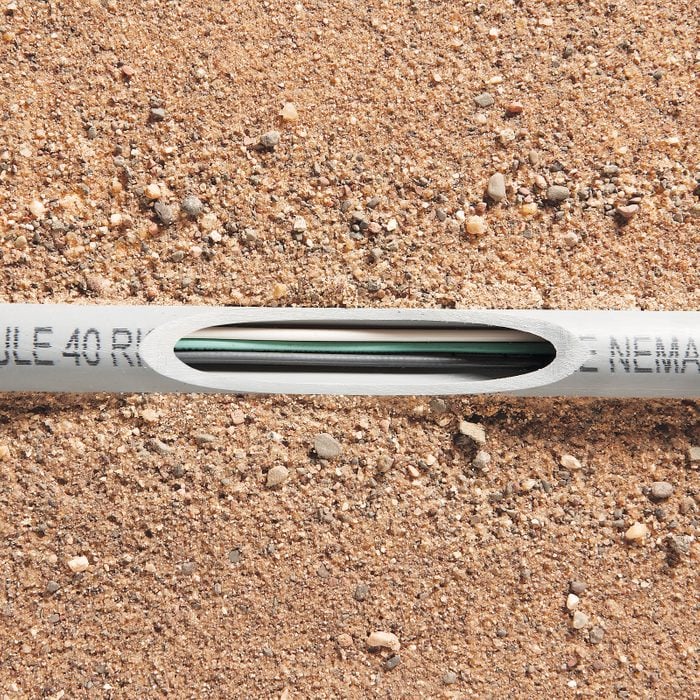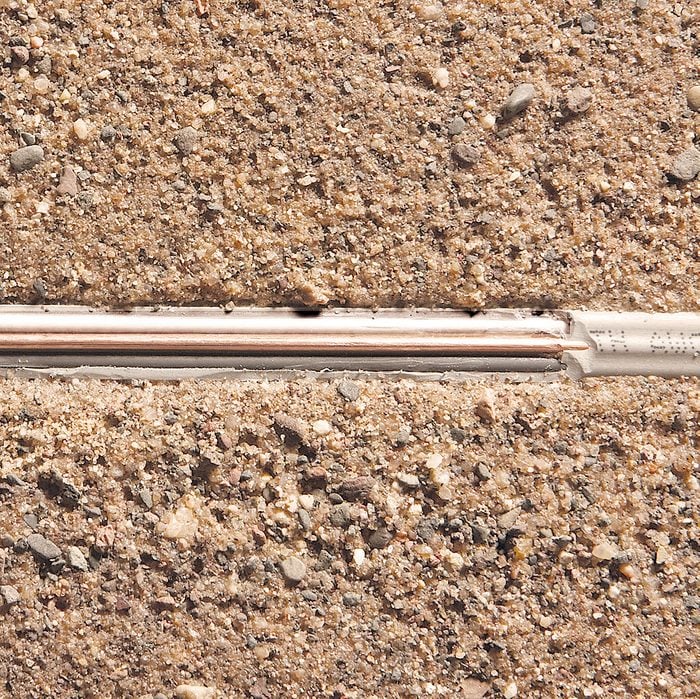Four Burial Depth Options for Underground Wiring
Decide how much digging you’re prepared to do and how deep your trench will be. This helps determine the type of wiring and the method you’ll use. Underground cable and wire can be installed at different depths, depending on the type of conduit, wire or cable.
Six inches
Install galvanized rigid metal electrical conduit with individual insulated wires six inches deep.
- The wires are pulled through the conduit once the entire conduit run is complete, from end-to-end.
- Wires must be rated for use in a wet location, such as Type THWN-2 (thermoplastic/wet location/nylon jacket).
Twelve inches
Install GFCI-protected direct-buried Type UF cable 12 inches deep.
- The GFCI protection is a trade-off that provides enhanced electrical safety while reducing the need for a deeper trench.
Eighteen inches
Install PVC conduit with individual insulated wires 18 inches deep.
- The wires are pulled through the conduit once the entire conduit run is complete, from end-to-end.
- Wires must be rated for use in a wet location, such as Type THWN-2 (thermoplastic/wet location/nylon jacket).
Twenty-four inches
Install Type UF cable for the entire run 24 inches deep.
- This is another trade-off between depth and physical protection.
- Because the direct-buried cable is alone in the bottom of the trench without conduit or GFCI protection, it must be installed deeper in the ground.
Read on for the specifics about each option.
Get an Electrical Permit and Call 811
Before we dig into the specifics, here’s your reminder to follow these essential safety precautions when burying underground cable:
- Call your local building inspection department to find out if an electrical permit and inspections are required for your project.
- The electrical inspector will verify the depth of the trench and inspect the wiring before it’s covered.
- The few dollars you spend on inspection fees are readily offset by having a professional approve your work and make sure it’s safe.
- Contrary to the notion that building permits automatically increase property taxes, a complete record of permits and inspections at the city office will help to facilitate a smooth transaction if you sell your home.
- If your wiring is connected and energized when the inspector arrives, they may perform the final inspection at the same time, saving them another trip.
- In the U.S., call 811 or visit www.call811.com to have your utilities marked. In Canada, visit www.clickbeforeyoudig.com. This prevents damage to public utility infrastructure (electric, gas, water, cable TV, telephone, optical fiber, etc.) which could leave your neighborhood without utility service for hours or days and expose you to legal action.
Note: If you need to leave the trench open for an extended period, install barricades around it so it isn’t a safety hazard for people and pets.
The Six-Inch Option
If you have rocky or heavy clay soil or tree roots that makes digging a chore, or you only need to run wire a short distance, go this route. It minimizes digging and provides superior protection for the buried wiring.
- Install galvanized metal rigid electrical conduit with individual insulated wires pulled inside the completed conduit run.
Pro tip: The wires need to be rated for use in a wet location. Look for a “W” embossed in the marking on the wire, i.e. THWN-2.
- This method works for any size branch circuit, from 15 to 60 amperes or even larger.
- The downside is the cost. Ten feet of 1/2-inch galvanized rigid metal conduit is about $37, and you have to buy reels of insulated copper wires that are pulled into the conduit.
The 12-Inch Option
Often the best choice for small backyard electrical projects. It’s only one foot deep, and you don’t have to put the cable inside expensive metal conduit.
Install direct-buried Type UF-B cable, provided the branch circuit is:
- Provided with ground-fault circuit-interrupter (GFCI) protection before it enters the ground;
- Limited to 120 volts;
- Protected by a circuit breaker or fuse rated no higher than 20 amperes.
Don’t forget you need to install conduit to protect the cable from physical damage where it transitions from aboveground to underground.
The 18-Inch Option
This method lets you run just about any size branch circuit, so it’s good for running electricity to various backyard projects or detached buildings. It also lets you add more wires later.
If you decide in the future to install a switch loop to control the shed lights from inside your house, you can easily pull a couple of extra wires into the PVC conduit.
- Similar to the six-inch option, install individual insulated type THWN-2 wires inside PVC conduit once the entire run of conduit is complete.
- Another upside for this option: Reduced cost. Ten feet of 1/2-inch PVC conduit is only about $10.
The 24-Inch Option
Install direct-bury Type UF-B cable
- Keep in mind it needs protection from physical damage with Schedule 80 PVC conduit where the cable transitions from above grade to at least 18 inches below finished grade.
- Burying the cable 24 inches requires more digging. So this method only makes sense if you have granular soil that’s easy to dig, or you’re renting a trenching machine.

